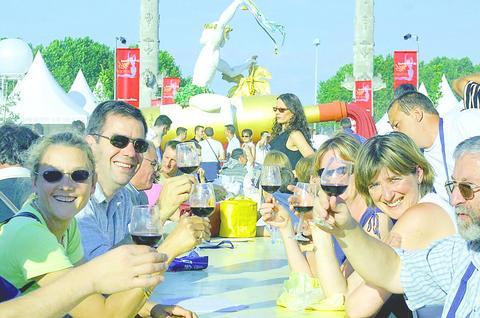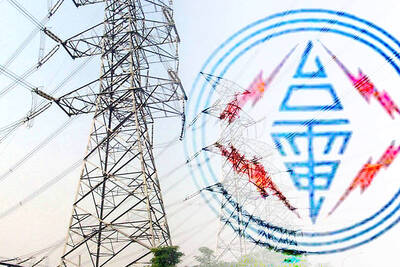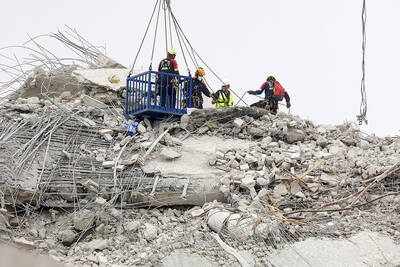The new wine is called Permis de Conduire, or Driving license, and will be marketed with a pink label which is the same color as the document that permits French people to sit behind the wheel of a car.
The wine in the 25cl bottle, the label claims, "corresponds to a concentration of alcohol not greater than 0.25mg per liter of exhaled air or 0.5 parts of alcohol to each 1,000 parts of blood, if two people share the bottle."
In other words, two people drinking one bottle of this wine will be able to drive a car without worrying about surpassing the legal limit of blood-alcohol content.

PHOTO: DPA
The wine will be launched later this month with the slogan "Keep your license."
This product is more than a clever marketing gimmick, it is evidence of an industry in deep crisis. Just like another new wrinkle in French dining -- the wine doggie bag.
Several hundred restaurants throughout the country now give their customers glossy white shopping bags with wine-colored ribbons to take their unfinished wine bottles home to "prolong their pleasure," as promotional fliers urge.
The bags are provided free of charge to restaurants by the Wine Council of Bordeaux, in response to a vigorous government program to cut down road fatalities and other alcohol-related deaths.
The objective of the program is to reduce the use of alcohol in France by 20 percent by the year 2007, and it has led to an acceleration in the decades-long decrease of wine consumption in the country.
Nowadays, the average French man and woman over the age of 15 consumes about 68l of wine per year, exactly half the amount drank in 1960, when French society considered wine a staple like bread, and considerably below the 77l per year consumed in 1990.
In addition, French wines are being squeezed on foreign markets by the so-called "new age" wines, made in South Africa, Australia, Chile and the US. As a result, exports of wines from the Bordeaux and Burgundy regions were down about 8 per cent in 2003.
The resulting accumulation of wine reserves has led to a steep drop in the barrel price of all but the most prestigious wines, which has many French vintners worried about their future.
"Today, I am earning zero," one Bordeaux winemaker said. "If that continues, I will stop."
His problem, he said, was that he can not repay bank loans taken out in the 1990s when Bordeaux wine sold for more than 1,500 euros (currently about US$1,820) per 900l barrel. Today, the price has sunk below 750 euros per barrel.
To emerge from the crisis, French winemakers have gone on the offensive, beginning with a concerted effort to reduce the amount of wine they produce.
Instead of the 7 million hectoliters they are capable of producing this year, vintners in Bordeaux have decided to destroy some of their vines and commercialize only 5 million hectoliters, hoping to force prices up.
In addition, and perhaps more important, French winemakers have embarked on a political and media campaign to change the status of their product.
A so-called "White Book" to be presented to Prime Minister Jean-Pierre Raffarin later this month declares that wine should be classified as a nutriment rather than an alcoholic beverage.
The consequence of such a change would be to exempt wine from limitations on advertising that forbid regional vintners from publicizing anything about their products but its name, alcohol content and place of sale, as prescribed by a 1991 law.
It would also permit winemakers to sponsor public events, another form of public relations currently forbidden to producers of alcoholic beverages.
Relying on a number of scientific studies, the authors of the "White Book" maintain that wine is "a food, not a drug," and that regular and moderate consumption has a number of health benefits, particularly for the cardiovascular system and in combatting Alzheimer's disease.
The editor of the White Book is Alain Suguenot, a representative in the National Assembly from the city of Beaune, in the wine region of Burgundy. He charges that French wine is being victimized by "a prohibitionist lobby that demonizes it."
"Wine," he declared, "is a product of civilization and public health that must be defended in France and abroad.

That US assistance was a model for Taiwan’s spectacular development success was early recognized by policymakers and analysts. In a report to the US Congress for the fiscal year 1962, former President John F. Kennedy noted Taiwan’s “rapid economic growth,” was “producing a substantial net gain in living.” Kennedy had a stake in Taiwan’s achievements and the US’ official development assistance (ODA) in general: In September 1961, his entreaty to make the 1960s a “decade of development,” and an accompanying proposal for dedicated legislation to this end, had been formalized by congressional passage of the Foreign Assistance Act. Two

March 31 to April 6 On May 13, 1950, National Taiwan University Hospital otolaryngologist Su You-peng (蘇友鵬) was summoned to the director’s office. He thought someone had complained about him practicing the violin at night, but when he entered the room, he knew something was terribly wrong. He saw several burly men who appeared to be government secret agents, and three other resident doctors: internist Hsu Chiang (許強), dermatologist Hu Pao-chen (胡寶珍) and ophthalmologist Hu Hsin-lin (胡鑫麟). They were handcuffed, herded onto two jeeps and taken to the Secrecy Bureau (保密局) for questioning. Su was still in his doctor’s robes at

Last week the Democratic Progressive Party (DPP) said that the budget cuts voted for by the China-aligned parties in the legislature, are intended to force the DPP to hike electricity rates. The public would then blame it for the rate hike. It’s fairly clear that the first part of that is correct. Slashing the budget of state-run Taiwan Power Co (Taipower, 台電) is a move intended to cause discontent with the DPP when electricity rates go up. Taipower’s debt, NT$422.9 billion (US$12.78 billion), is one of the numerous permanent crises created by the nation’s construction-industrial state and the developmentalist mentality it

Experts say that the devastating earthquake in Myanmar on Friday was likely the strongest to hit the country in decades, with disaster modeling suggesting thousands could be dead. Automatic assessments from the US Geological Survey (USGS) said the shallow 7.7-magnitude quake northwest of the central Myanmar city of Sagaing triggered a red alert for shaking-related fatalities and economic losses. “High casualties and extensive damage are probable and the disaster is likely widespread,” it said, locating the epicentre near the central Myanmar city of Mandalay, home to more than a million people. Myanmar’s ruling junta said on Saturday morning that the number killed had